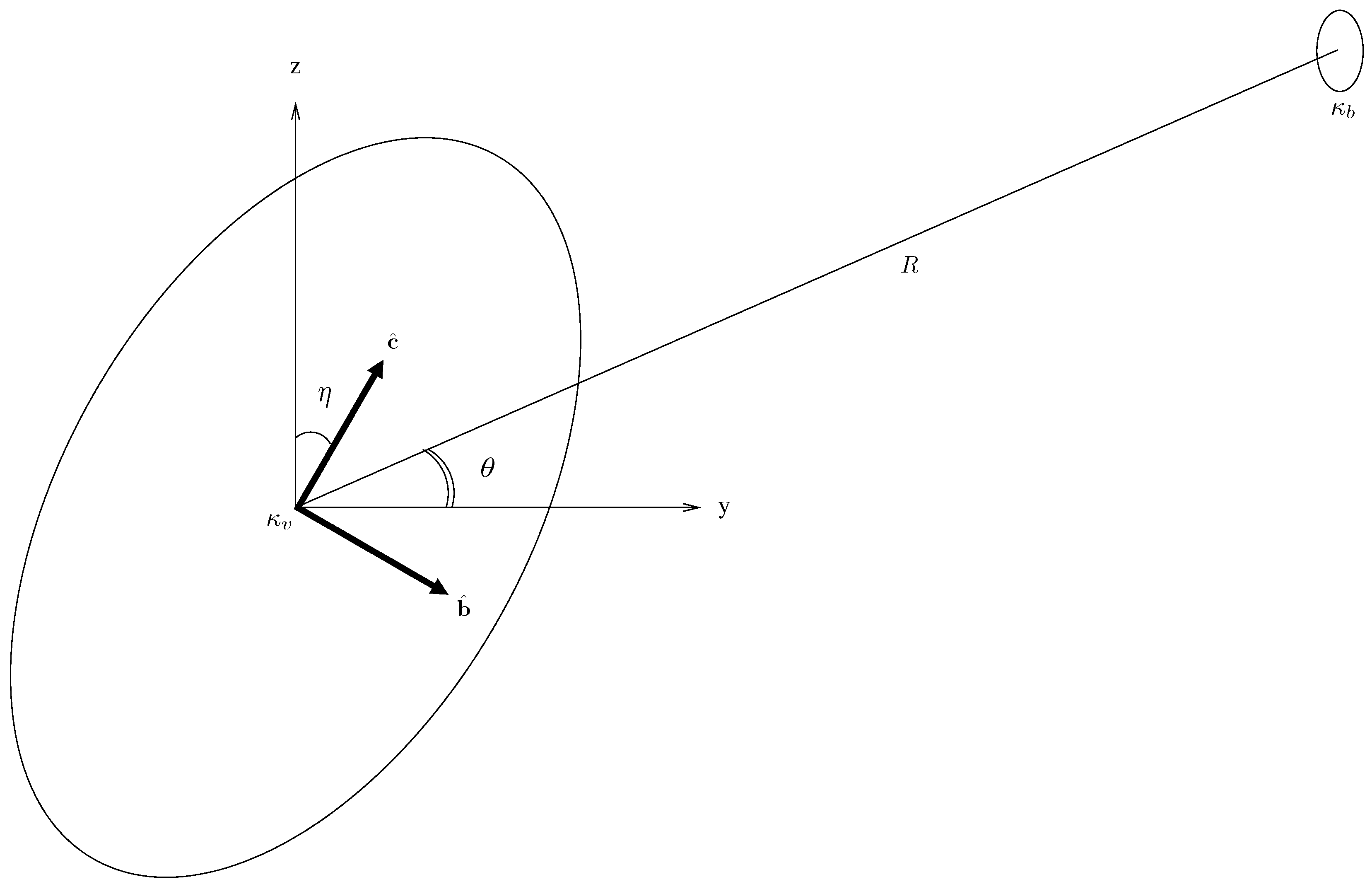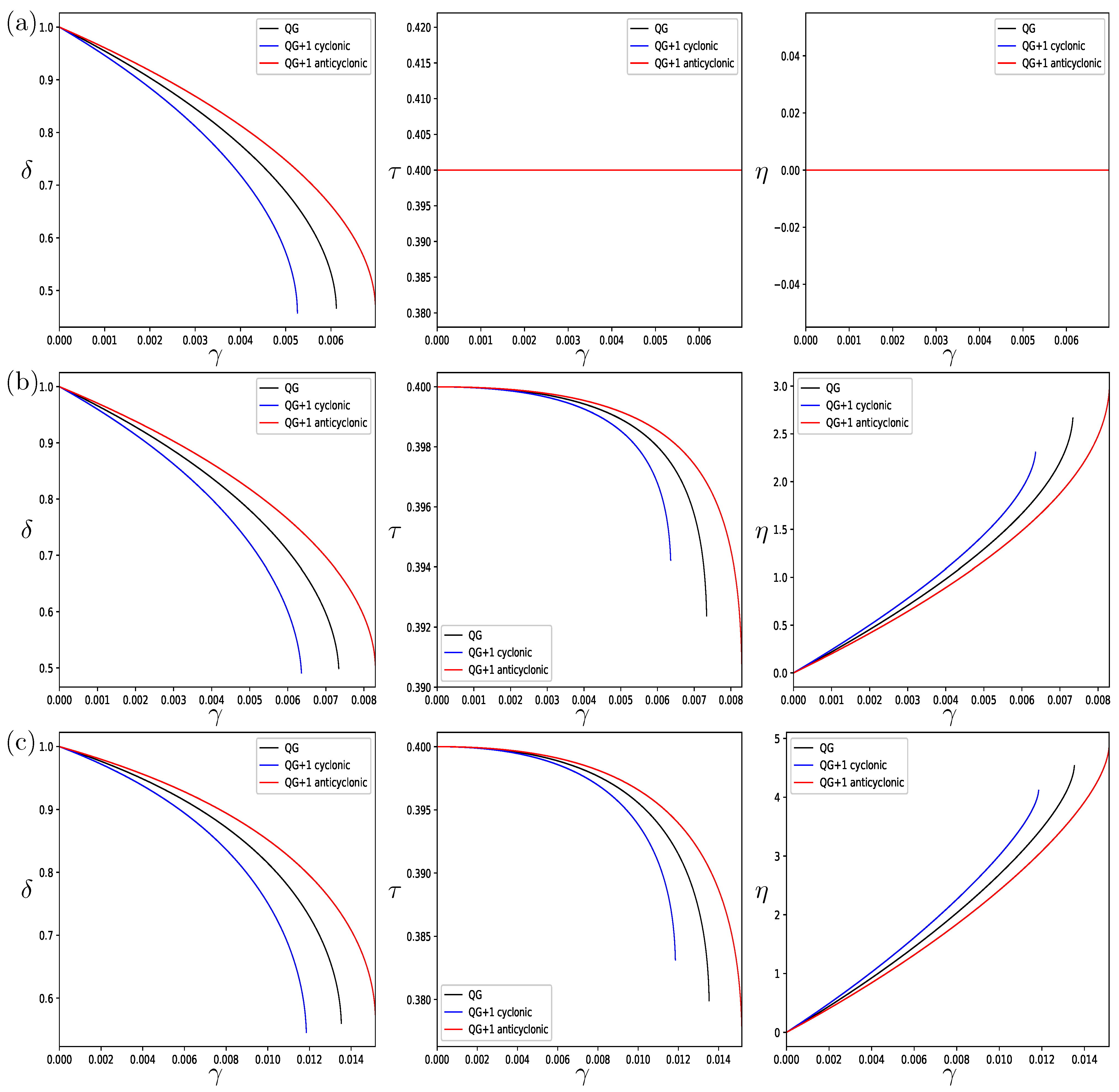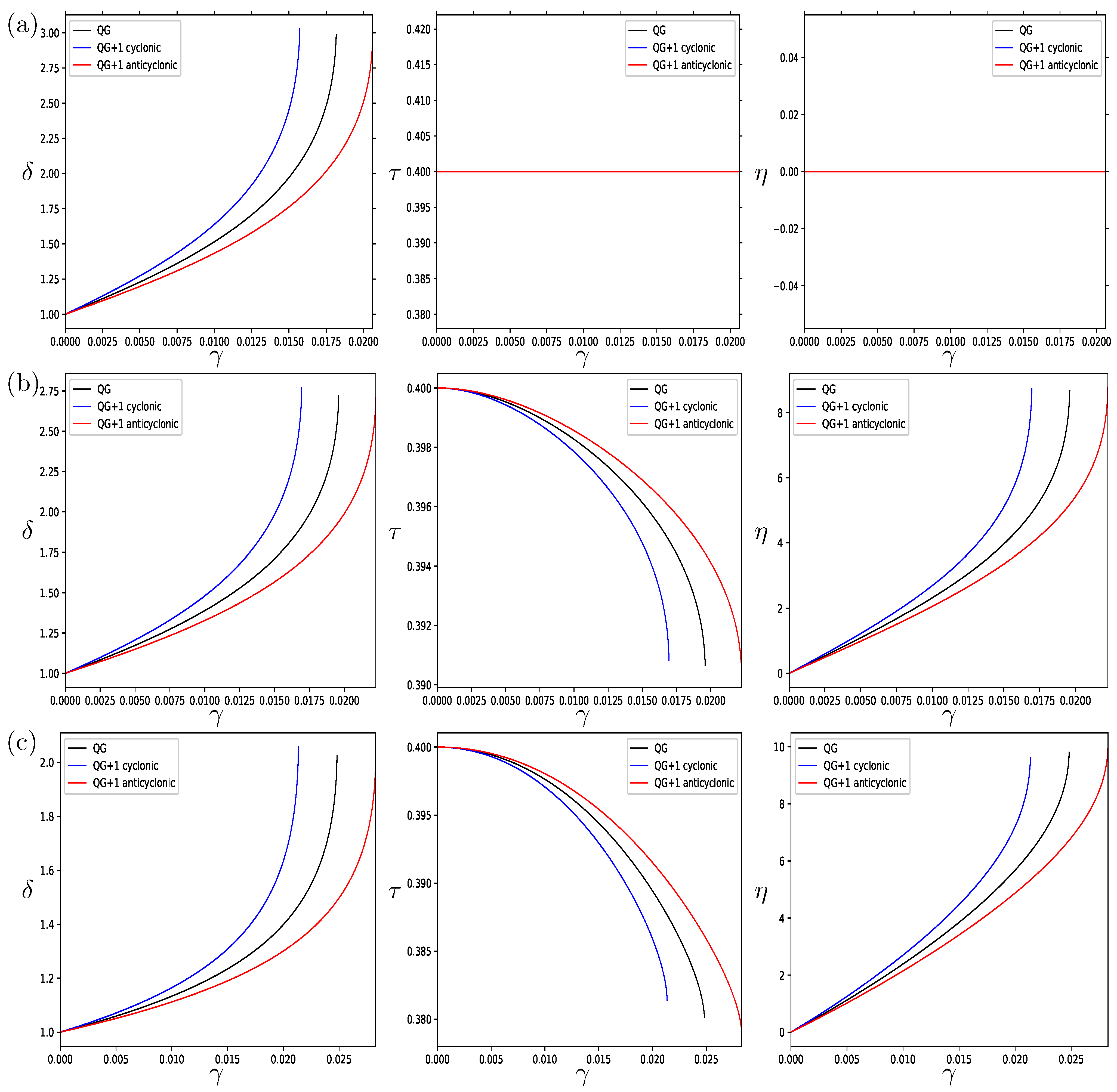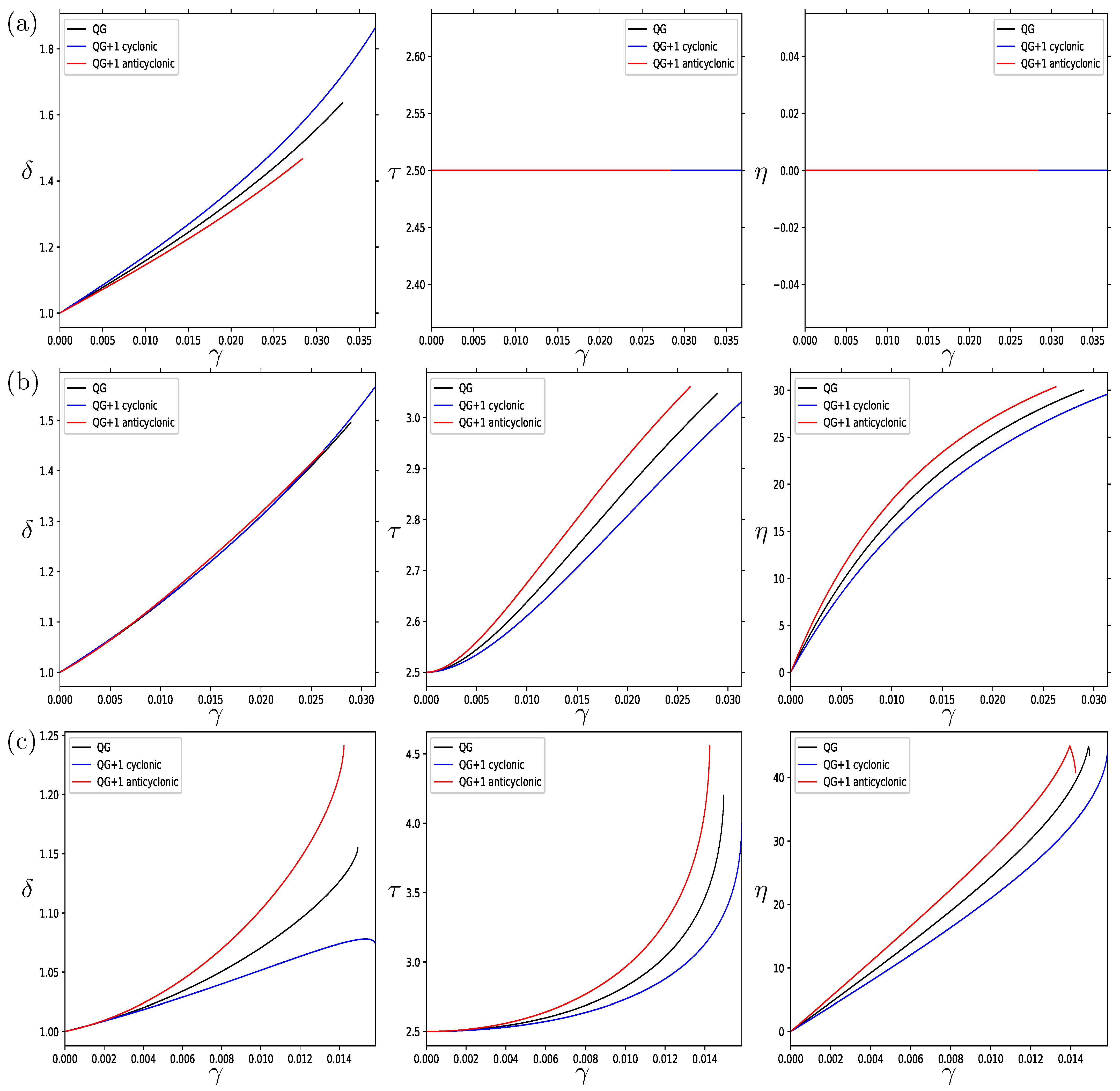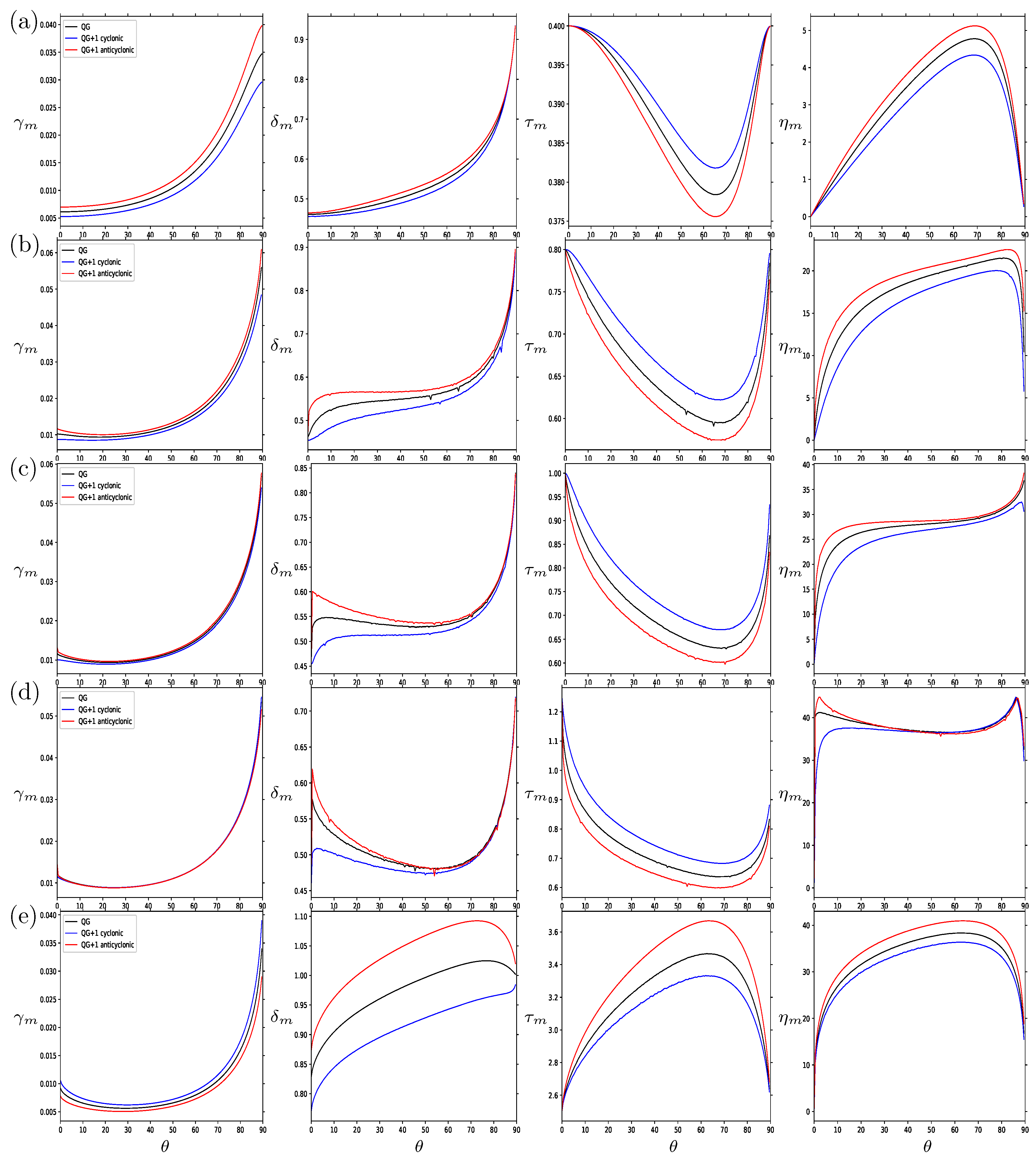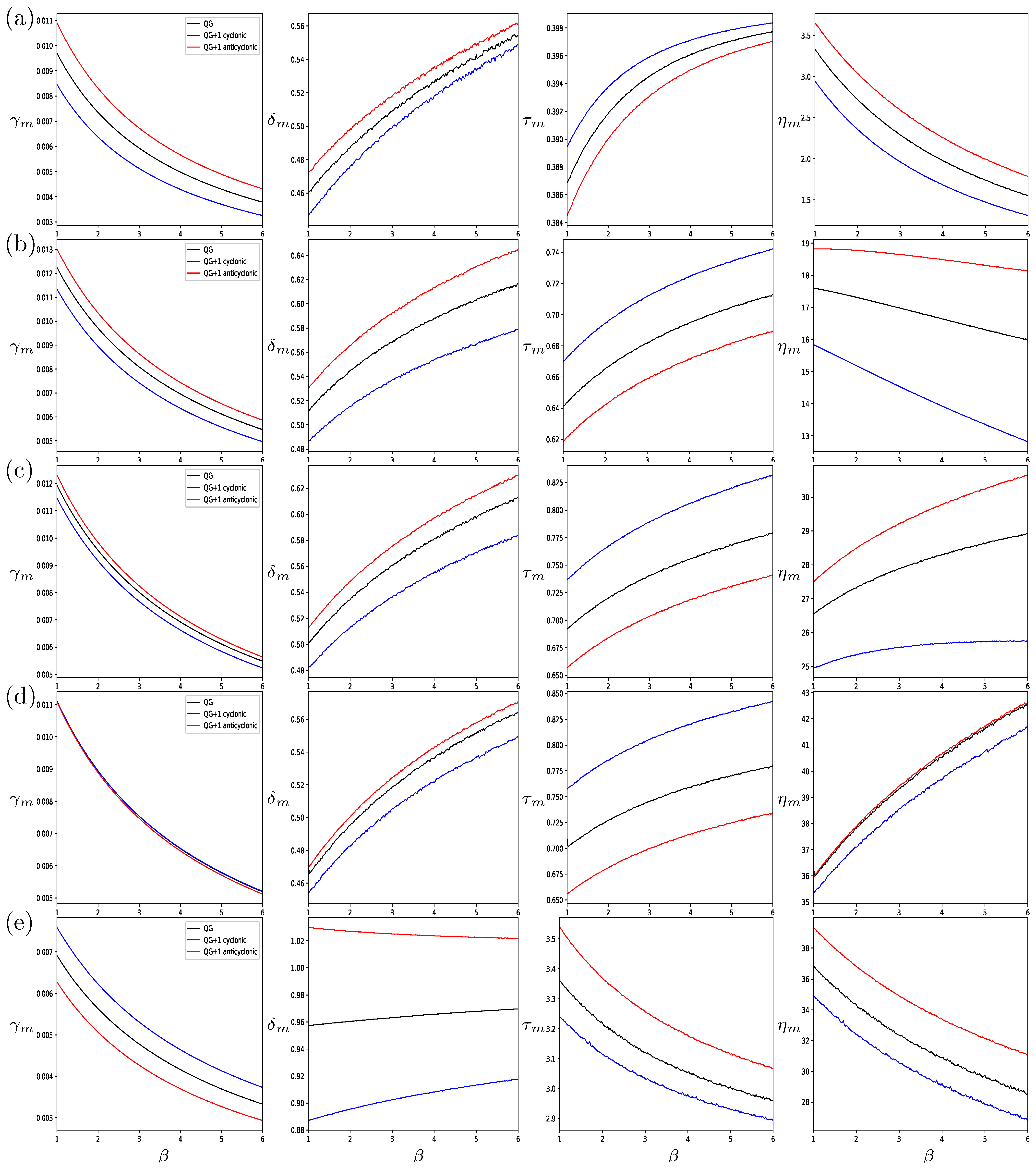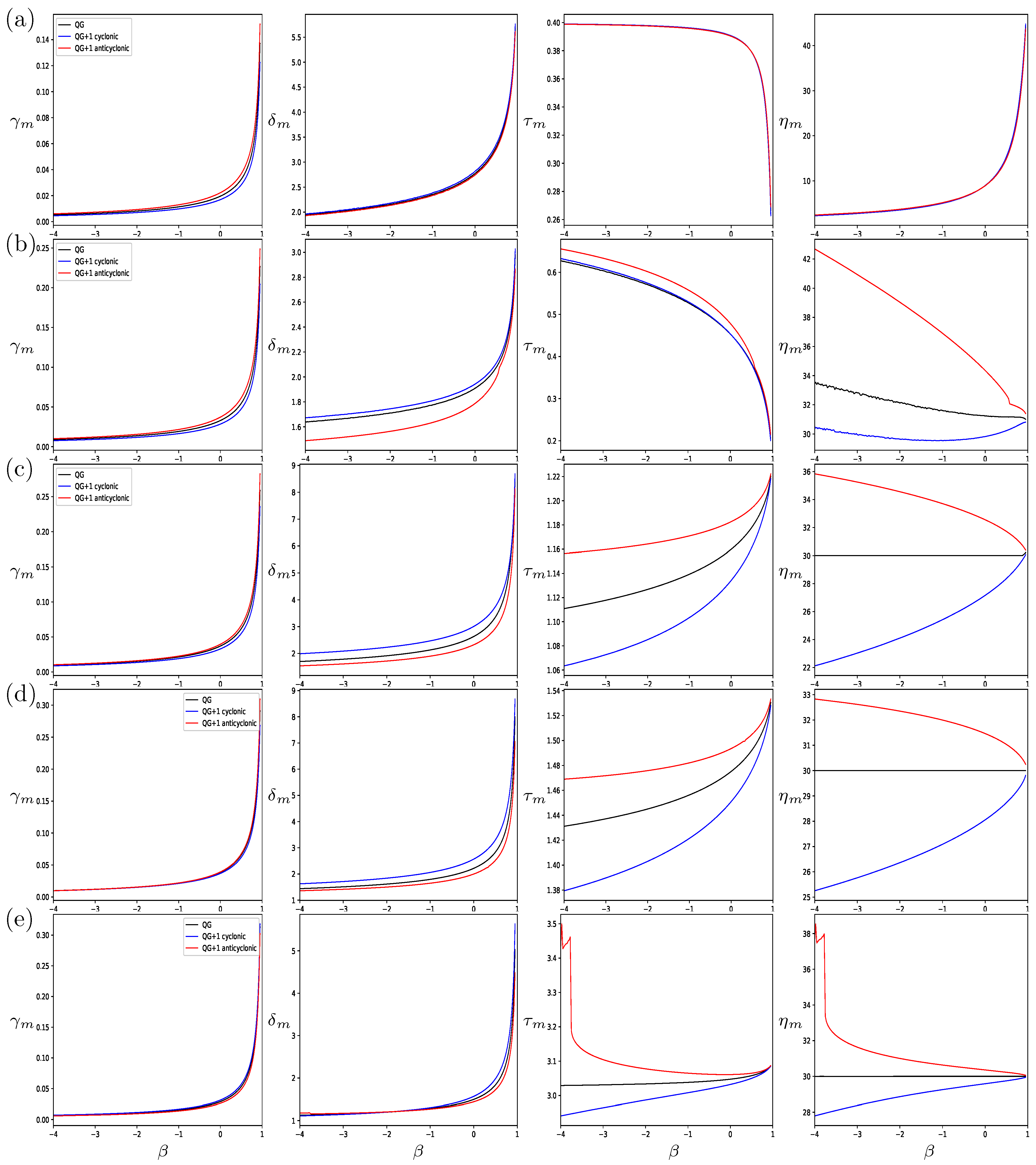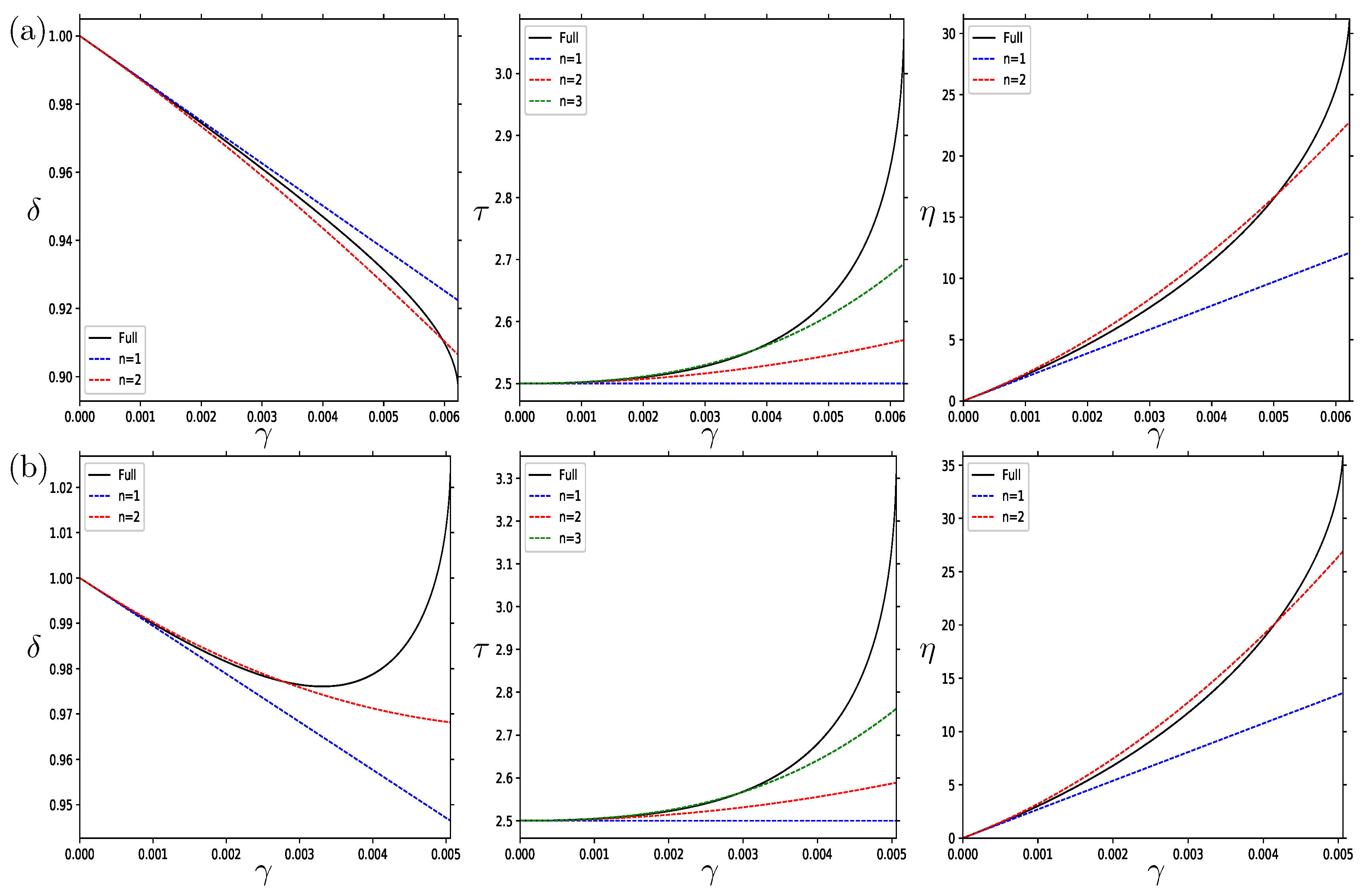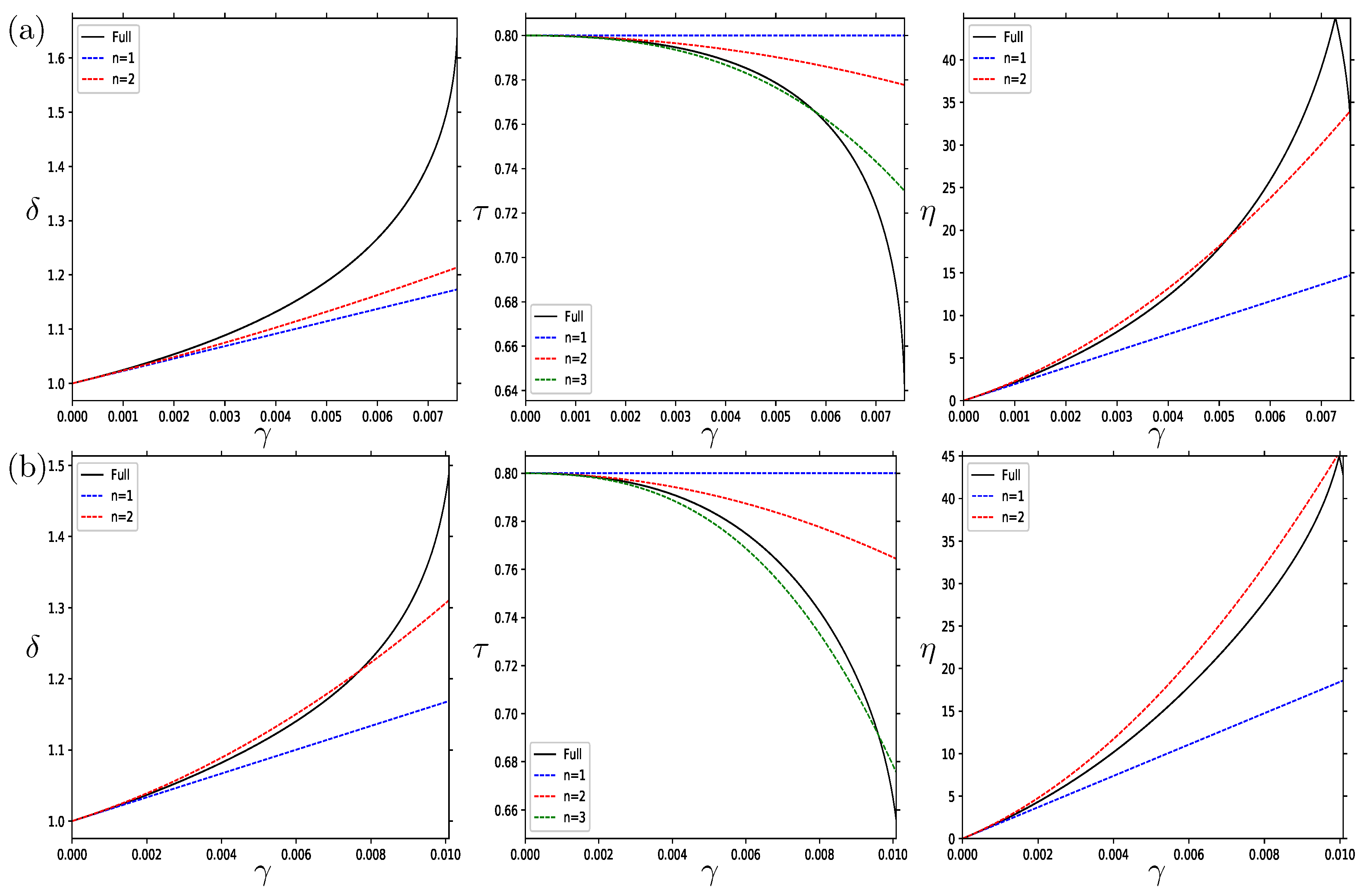Here we compute the equilibria for a range of values of the background flow parameters and and for a number of values of the height-to-width aspect ratio . For each height-to-width aspect ratio considered, we examine both like-signed interactions with and opposite-signed interactions with , while we consider values of the angle of incidence . For every case, we will compute the QG, QG + 1 cyclonic, and QG + 1 anticyclonic equilibria up to the margin of stability, and we define the magnitude of the marginal strain rate for QG, QG + 1 cyclonic, and QG + 1 anticyclonic equilibria as , , and , respectively.
The steady states of this system have recently been solved in [
17], although the focus there was on the magnitude of the marginal and critical turning point strain and how they change with the background flow parameters. Here we wish to revisit this, although we focus on how the vortex shape and orientation change with the background flow and quantify the asymmetry between the cyclonic and the anticyclonic equilibria. We characterize the shape of the vortex by defining the horizontal aspect ratio as
and the vertical aspect as
, while the orientation is specified by the tilt angle
(
Figure 1). Using these aspect ratios, the ellipsoid semi-axis lengths are given by
,
, and
, where
, thus fixing the volume of the ellipsoid without loss of generality. Note that the vertical aspect ratio is different than the height-to-width aspect ratio
and that it can vary with different strain values.
3.1. Vortex Characteristics as a Function of Strain
In
Figure 2, we plot the horizontal and vertical aspect ratios and the tilt angle as a function of strain for QG (black), QG + 1 cyclonic (blue), and QG + 1 anticyclonic (red) equilibria for three different values of
in the case of an oblate vortex with
and considering the case of like-signed interactions with
.
For the case when
,
Figure 2a, only the horizontal aspect ratio varies with the strain. That is, when there is no vertical shear, there is no tilting of the vortex, and the vertical aspect ratio is equal to the height-to-width aspect ratio. On the other hand, the horizontal aspect ratio decreases with increasing strain, with the cyclonic values being less than the anticyclonic values for a given strain value. However, as the marginal strain rate of the anticyclonic equilibria are higher than those of the cyclones, the marginal horizontal aspect ratio ends up being the same for anticyclones and cyclones. For the cases
and
in
Figure 2b and
Figure 2c, respectively, the equilibria tilt angle increases as the strain increases. As the equilibria increasingly tilt with the strain, the vertical aspect ratio
decreases. For a given strain rate, the deformation of the cyclonic vortex is greater than the anticyclonic case. However, the marginal strain is greater for the anticyclonic vortex, and so at the marginal strain, the anticyclone is more tilted and has a smaller vertical aspect ratio than the cyclone.
In
Figure 3, we plot the parameters for the case of a prolate vortex with
. When there is no vertical shear,
(
Figure 3a), the behavior is similar to that which was seen for the oblate case, although in this case, at the marginal strain, there is stronger asymmetry of the horizontal aspect ratio, with the horizontal aspect ratio of the cyclonic equilibrium being much less than the anticyclonic equilibrium.
When there is vertical shear,
Figure 3b,c, there is even stronger asymmetry in the horizontal aspect ratio, with the cyclonic case decreasing with strain, while the anticyclonic case initially decreases but eventually increases and becomes larger than its initial value. Unlike the oblate case, the vertical aspect ratio increases with the strain rate, while the vortex has a much larger degree of tilting. Additionally, conversely to the oblate case, for a given value of the strain rate, the anticyclonic vortex is more deformed and has a greater tilt angle than the cyclonic case.
Next, we consider the case of opposite-signed interactions with
and show the cases
and
in
Figure 4 and
Figure 5, respectively.
One significant difference between the opposite and like-signed cases is that the opposite-signed horizontal aspect ratio increases with the strain rate for both oblate and prolate cases, whereas this only occurs for anticyclonic prolate equilibria when there is vertical shear. Overall, the opposite-signed equilibria are more deformed than the like-signed equivalent cases, probably linked to the fact that the marginal strain values for opposite-signed interactions are much larger those for like-signed interactions. However, the overall asymmetry between the cyclonic and anticyclonic equilibria for the opposite-signed interactions is reduced in nearly all cases, except for the prolate case with
(
Figure 5c).
3.2. Asymmetry at the Marginal Strain
Now we examine how the shape characteristics of the cyclonic and anticyclonic equilibria at the marginal strain rate change with the background flow parameters. Similar to how we refer to the marginal strain rates for QG, QG + 1 cyclonic, and QG + 1 anticyclonic equilibria, we define the marginal shape characteristics for the QG, QG + 1 cyclonic, and QG + 1 anticyclonic respectively as:
,
, and
for the marginal horizontal aspect ratio;
,
, and
for the marginal vertical aspect ratio; and
,
, and
for the marginal tilt angle. First, we will consider the dependence on the vertical offset
, beginning with the case of like-signed interactions in
Figure 6.
We plot the marginal strain rate
and the shape and orientation variables at the marginal strain rate as a function of
for the cases when
and for (a)
, (b)
, (c)
, (d)
, and (e)
. The marginal strain rate shows similar dependence on
, with the the largest values occurring at
. However, for the oblate cases (
),
, meaning that the anticyclonic oblate vortices are more stable, while the reverse is the case for the prolate cases (
). The horizontal aspect ratio
also tends towards larger values for large
, although the dependence on
changes with
. In particular, the most prolate case
differs from the other cases, as it has the strongest cyclone–anticyclone asymmetry at large
, whereas for the other values of
, the asymmetry is strongest for low
. For all aspect ratios,
, and the value of
is closest to unity for
, i.e., for the largest value of vertical shear, the equilibrium horizontal cross section becomes more circular. For the vertical aspect ratio, there is similar behavior for the cases where
, with
decreasing with
until it reaches
, at which point it increases again, returning to near the initial value, with
. However, for
(
Figure 6e),
increases with
, reaching a maximum at about
, before returning to the initial value. In this case,
. The marginal tilting angle
for all
initially increases with
, although this increase is more abrupt for
close to unity. For most values of
, the tilting angle decreases at large
, except for the case
, where the value remains high for the largest
. Overall, looking at the asymmetry in the shape and orientation, it is clear that the anticyclonic equilibria undergo greater deformation than the cyclonic ones. The greatest difference between the anticyclonic and cyclonic marginal shape most often occurs at
, with the exception of when
is close to unity (
Figure 6b,c,e), with
and
having the largest asymmetry when
.
In
Figure 7, we consider the dependence on
for the opposite-signed case with
. Here, there is very different behavior for the most oblate case,
, and for the other cases. For the strongly oblate case in
Figure 7a, we see that
, although there are very few differences between the shape and orientation of the cyclonic and anticyclonic equilibria. The horizontal aspect ratio decreases with
, while the vertical aspect ratio initially decreases to a minimum at
before increasing back to its original value. Conversely, the tilt angle increases to a maximum of
before returning to zero. For
, the behavior of all the variables looks dramatically different from the most oblate case, with a kink appearing in the dependence at
. This kink has been seen before in [
17,
24] and is associated with a swap in the horizontal axes
a and
b of the equilibria when the shape matrix component
. It marks a transition in the behavior of the variables, with the vertical aspect ratio and the tilt angle reaching a maximum at this point before decreasing, while for the horizontal aspect ratio, it is close to the point where we go from
to
. For
, interestingly, when there is no vertical shear,
, and the horizontal cross section is more deformed, with
much larger than 1; however, as the vertical shear increases, the horizontal cross section becomes more circular. In the case of the vertical aspect ratio and the tilt angle, the greatest asymmetry between the cyclonic and anticyclonic equilibria occurs where the kink occurs, whereas for the horizontal aspect ratio, the strongest asymmetry occurs for
. Overall, the asymmetry is largest for the prolate cases (
).
Next, we look at how the shape characteristics of the equilibria at the marginal strain rate change with the parameter
. In
Figure 8, we plot the equilibria conditions at the marginal strain as a function of
for the case of like-signed interactions.
For all values of , the marginal strain decreases with increasing , although there is a difference between the oblate and prolate cases, with the oblate anticyclonic equilibria being more stable than the cyclonic equilibria, , while the reverse is true for the prolate cases. The marginal horizontal aspect ratios have similar dependence on for all values of , with increasing with , moving towards unity; the only exception is for the most prolate case, where the value decreases as increases. In all cases, , with the strongest asymmetry occurring for . Similarly, for the vertical aspect ratio, we see different behavior for the most prolate case, with decreasing with , while for all the other values of , increases with . In all cases, approaches as increases. For the tilting angle , there seems to be a separation between the cases with close to unity and the extremely oblate and prolate cases, with the most oblate and prolate values decreasing with , while the other cases increase with . Overall, the asymmetry tends to increase with , with only the most oblate and prolate cases defying this trend for .
In
Figure 9, we look at the dependence on
for opposite-signed interactions.
Here, the marginal strain behaves the same for all values of
, with
increasing rapidly as
goes to 1. These larger marginal strain values on the approach to
mark extreme deformation of the horizontal cross section of the equilibria, with
increasing dramatically for all values of
. Instead, the behavior of the marginal vertical aspect ratio
changes with
, with the most oblate cases (
Figure 9a,b) decreasing with
, whereas for the other values of
, it increases with
, except for
for
(
Figure 9e). Apart from the most oblate case
, both the vertical aspect ratio
and the tilt angle
show increasing asymmetry as
decreases, with the anticyclonic values tending to increase while the cyclonic values decrease. Generally, it appears that, as we move away from
for both like-signed and opposite-signed interactions, the asymmetry increases.
3.3. Approximate Equilibrium Solutions
In order to clarify how the vortex characteristics depend on the background flow, it is worth trying to find approximate solutions for the equilibria. Given the form of the background flow, we have found that the equilibria are always tilted about the
x-axis, implying that the axis vectors are:
This means that the shape matrix always has a particular form, with
, and so the other components can be written in terms of the parameters
,
, and
:
Similarly the self-induced flow matrix has only certain non-zero components, which can be written as:
where the coefficients are:
As a result of the form of the shape and flow matrices, equilibrium Equation (
23) reduces significantly to just two equations:
Given these two equations, as well as the fact that the
component is constant, we have three equations in the three unknown variables
,
, and
. However, since the self-induced flow matrix
depends on these variables through the elliptical integrals, these equations cannot be directly solved. However, we can obtain approximate solutions by expanding these variables in the strain rate, i.e.,:
We assume that the unperturbed solution when no strain is applied has a circular cross section,
, is upright,
, and that the initial vertical aspect ratio is equal to the height-to-width aspect ratio, i.e.,
. We can Taylor expand the self-induced flow matrix components about this unperturbed configuration as follows:
where derivatives with respect to the aspect ratios can be related to derivatives with respect to the axis lengths by:
and where we use formulas for the derivatives of the elliptical integrals that have been derived in previous works [
17,
24]. By applying these formulas in the equilibrium relations in Equation (29) and matching the coefficients at different orders, we get, at the first order:
and at the second order, we find:
where
where all of these coefficients are evaluated at the unperturbed state with
,
, and
. From these equations, we see that, when there is no vertical shear (
), the
and
disturbance terms vanish, with only the horizontal aspect ratio
varying. In fact, the vertical aspect ratio has no linear dependence on the strain-rate, i.e.,
. Additionally, there is no dependence on
at the first order. The dependence of
on
implies that the values with the largest magnitude will tend to occur for
; therefore, as the cyclonic and anticyclonic strain rates are differently signed, we would expect the strongest asymmetry to occur at this value, i.e., when there is no vertical shear. This is overall what we have seen when examining the dependence on
in
Figure 6 and
Figure 7 for like-signed and opposite-signed interactions, respectively. On the other hand, the dependence of
on
means that the largest magnitudes occur for
. This explains to some extent why the strongest asymmetries in
seen in
Figure 6 and
Figure 7 occur for larger values of
, although it tends to occur at even higher values,
, implying that higher-order terms play a role.
The dependence on
first appears at the second order for
and
, but not for
. The appearance of
in
and
means there will be a change in sign for these terms passing from the like-signed (
) and opposite-signed cases (
). In order to see the dependence of
on
, we have to go to the next order, which can be easily done using the condition of constant
and gives:
while
has a relatively simple form, the third order of
and
is significantly more complicated depending on second- and third-order derivatives of the elliptical integrals, and so we do not compute them here. However, the third-order coefficient for
reveals the dependence on
through the appearance of
in Equation (
36). For
, the
term is multiplied by
, meaning that the sign of this term also depends on whether the vortex is oblate or prolate, and so both
and
will have a strong dependence on
, as we have seen in
Figure 8 and
Figure 9.
In
Figure 10a,b we plot
,
, and
as a function of
for the cyclonic and anticyclonic cases, respectively, where
,
, and
.
We plot the perturbation solutions at the first order (dashed blue curve) and the second order (dashed red curve), as well as the full solution (solid black curve). For the vertical aspect ratio, we also plot the third-order solution (green curve). For low values of the strain, both the first- and second-order perturbation solutions remain close to the full solution. At larger strain rates, the variables depart from the linear solution, with the direction of this deformation being captured by the higher-order perturbation solutions. In particular, the large asymmetry in , with the cyclonic value decreasing as the anticyclonic value increases, is initially captured by the second-order perturbation. The change in the anticyclonic trend is due to the fact that, for like-signed interactions, the anticyclonic strain is negative, and so there is a sign change between the first- and second-order terms, i.e., . However, as the strain-rate approaches the marginal value, even the second-order and third-order corrections cannot capture the change in the shape and orientation, implying that even higher-order terms are needed to fully capture the deformation.
In
Figure 11, we plot the perturbation values for the opposite-signed case of an oblate vortex, with
,
, and
.
This case is one in which we have previously seen (
Figure 9b) that there is strong asymmetry in the tilt angle. This asymmetry in
is fairly well captured up to high strain values. For
and
, the perturbation approximation captures the equilibria for low strain rates. However, as was seen for the like-signed case, as we approach the marginal strain rate, the error grows, particularly for
, implying the need for higher-order corrections.
